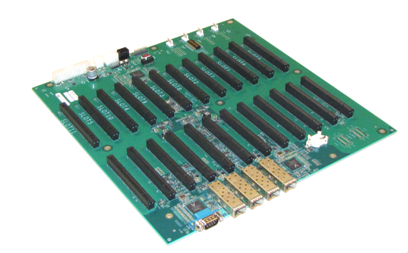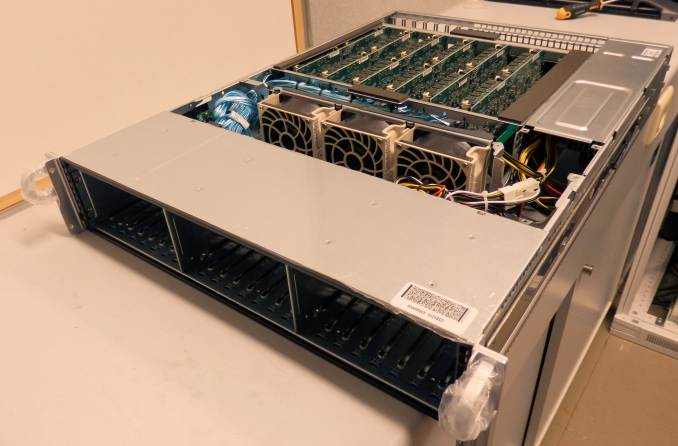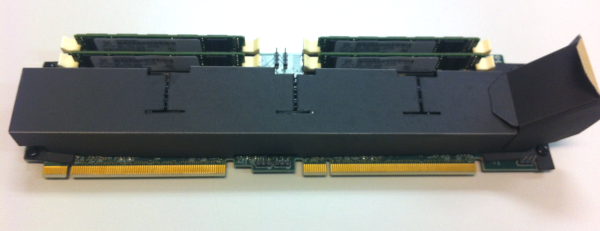Calxeda's ARM server tested
by Johan De Gelas on March 12, 2013 7:14 PM EST- Posted in
- IT Computing
- Arm
- Xeon
- Boston
- Calxeda
- server
- Enterprise CPUs
It's a Cluster, Not a Server
When unpacking our Boston Viridis server, the first thing that stood out is the bright red front panel. That is Boston's way of telling us that we have the "Cloud Appliance" edition. The model with an orange bezel is intended to serve as a NAS appliance, purple stands for "web farm", and blue is more suited for a Hadoop cluster. Another observation is that the chassis looks similar to recent SuperMicro servers; it is indeed a bare bones system filled with Calxeda hardware.
Behind the front panel we find 24 2.5” drive bays, which can be fitted with SATA disks. If we take a look at the back, we can find a standard 750W 80 Plus Gold PSU, a serial port, and four SFP connectors. Those connectors are each capable of 10Gbit speeds, using copper and/or fiber SFP(+) transceivers.
When we open up the chassis, we find somewhat less standard hardware. Mounted on the bottom is what you might call the motherboard, a large, mostly-empty PCB that contains the shared Ethernet components and a number of PCIe slots.

The 10Gb Ethernet Media Access Controller (MAC) is provided on the EnergyCore SoC, but in order to allow every node to communicate via the SFP ports, each node forwards its Ethernet traffic to one of the first four cards (the cards in slots 0-3). These nodes are connected via a XAUI interface to one of the two Vitesse VSC8488 XAUI-to-serial transceivers that in turn control two SFP modules each. Hidden behind an air duct is a Xilinx Spartan-6 FPGA, configured to act as chassis manager.
Each pair of PCIe slots contains what turns this chassis into a server cluster: an EnergyCard (EC). Each EnergyCard contains four SoCs, each with one DIMM slot. An EnergyCard contains thus four server nodes, with each node running on a quad-core ARM CPU.
The chassis can hold as many as 12 EnergyCards, so currently up to 48 server nodes. That limit is only imposed by physical space constraints, as the fabric supports up to 4096 nodes, leaving the potential for significant expansion if Calxeda maintains backwards compatibility with their existing ECs.
The system we received can only hold 6 ECs; one EnergyCard slot is lost because of the SATA cabling, giving us six ECs with four server nodes each, or 24 server nodes in total. Some creative effort has been made to provide air baffles that direct the air through the heat sinks on the ARM chips.
The air baffles are made of a finicky plastic-coated paper, glued to gether and placed on the EC with plastic nails, making it difficult to remove them from an EC by hand. Each EC can be freely placed on the motherboard, with the exception of the Slot 0 card that needs a smaller baffle.
Every EnergyCard is thus fitted with four EnergyCore SoCs, each having access to one miniDIMM slot and four SATA connectors. In our configuration each miniDIMM slot was populated with a Netlist 4GB low-voltage (1.35V instead of 1.5V) ECC PC3L-10600W-9-10-ZZ DIMM. Every SoC provided was hooked up to a Samsung 256GB SSD (MZ7PC256HAFU, comparable to Samsung’s 310 Series consumer SSDs), filling up every disk slot in the chassis. We removed those SSDs and used our iSCSI SAN to boot the server nodes. This way it was easier to compare the system's power consumption with other servers.
Previous EC versions had a microSD slot per node at the back, but in our version it has been removed. The cards are topology-agnostic; each node is able to determine where it is placed. This enables you to address and manage nodes based on their position in the system.














99 Comments
View All Comments
JohanAnandtech - Wednesday, March 13, 2013 - link
Hmmm ... There is almost no info on how that hypervisor works. It is hard to imagine that kind of system would scale very well. How does it keep Cache coherent? Do you have info on that?timbuktu - Wednesday, March 13, 2013 - link
I can't speak directly to ScaleMP, but it looks similar to NUMALink.http://en.wikipedia.org/wiki/NUMAlink
Reading through this article about Calxedas, great job BTW, I couldn't help but think about the old SGI hardware that seemed pretty similar with MIPs (and later Itanium) processors connected through a switch with NUMALink. I haven't played with NUMALink directly in almost a decade, but back then cheaper Altix slabs were ring topology while higher end hardware was switched. In the end though, you could put together a bunch of 1U racks together and have a single system image. Like you mentioned though, cache coherency was exceptionally important. Since we have a uv here, I can point you to the documentation for that box.
http://techpubs.sgi.com/library/tpl/cgi-bin/getdoc...
Everything old is new again, I suppose. Well, except NUMAlink never went away. =D
Tunrip - Wednesday, March 13, 2013 - link
I'd be interested in knowing how the Xeon compared if you did the same test without the virtual machines.JohanAnandtech - Wednesday, March 13, 2013 - link
The website won't scale to 32 logical cores I am afraid... but we can try to see how far we can getColin1497 - Wednesday, March 13, 2013 - link
A better question might be "is 24 VM's a logical number to use?" Would more or fewer VM's work better? The appearance is that you have 24VM's because you have 24 ARM nodes?duploxxx - Wednesday, March 13, 2013 - link
very interesting, loved reading it. But although early in the ball game I do think there are other way better solutions in the pipe-line from the big OEM:HP Moonshot
http://h17007.www1.hp.com/us/en/iss/110111.aspx
JohanAnandtech - Wednesday, March 13, 2013 - link
Isn't remarkable how PR people manage to fill so many pages with "extreme" and "the future" without telling anything. Frustation became even higher when I clicked "get the facts" page. That is more like "You are not getting any facts at all".DuckieHo - Wednesday, March 13, 2013 - link
Since these are set up as webservers, what's the power consumption at say 20-40% load? Usually there is some load instead of completely idle.JohanAnandtech - Wednesday, March 13, 2013 - link
Good suggestion... you'll like to see a step by step power measurement like SpecPower right? Let me try that.DanNeely - Wednesday, March 13, 2013 - link
I'd be interested in seeing where, and what happens when you start pushing single chips to and slightly beyond their limits. Calxeda's hardware's proved competitive on a very friendly workload (which I didn't really expect would happen until their A15 product); but in the real world a set of small websites are unlikely to all have equal load levels. Virtual servers on larger CPUs should give more headroom for load spikes; so knowing what the limits on Calxeda's hardware are strikes me as fairly important.